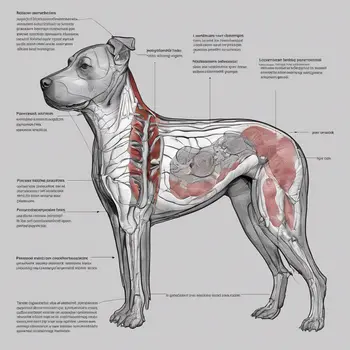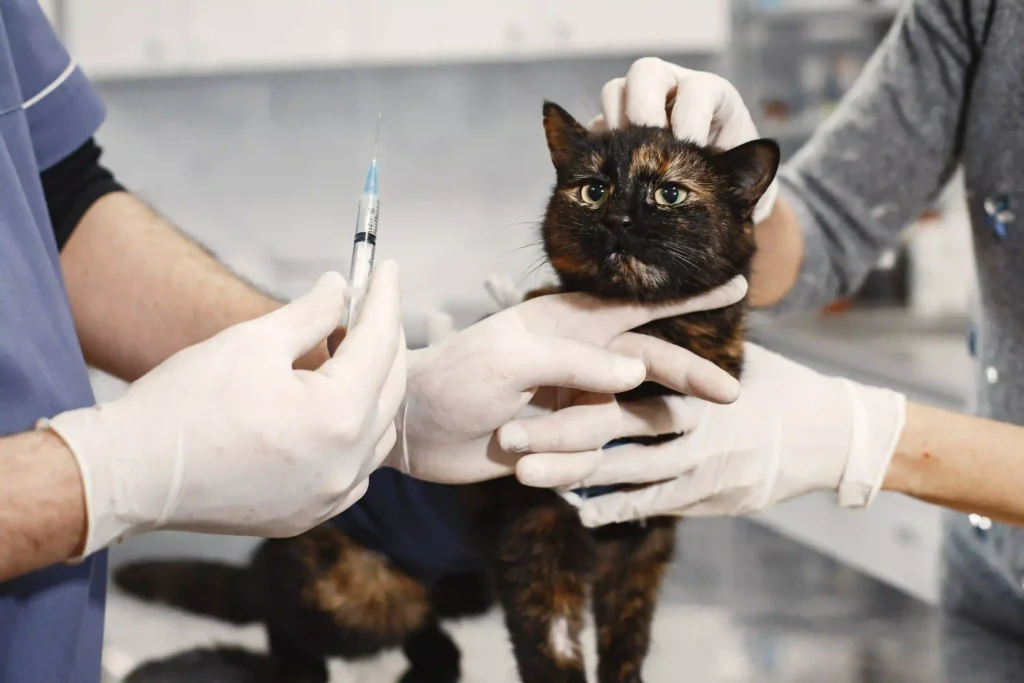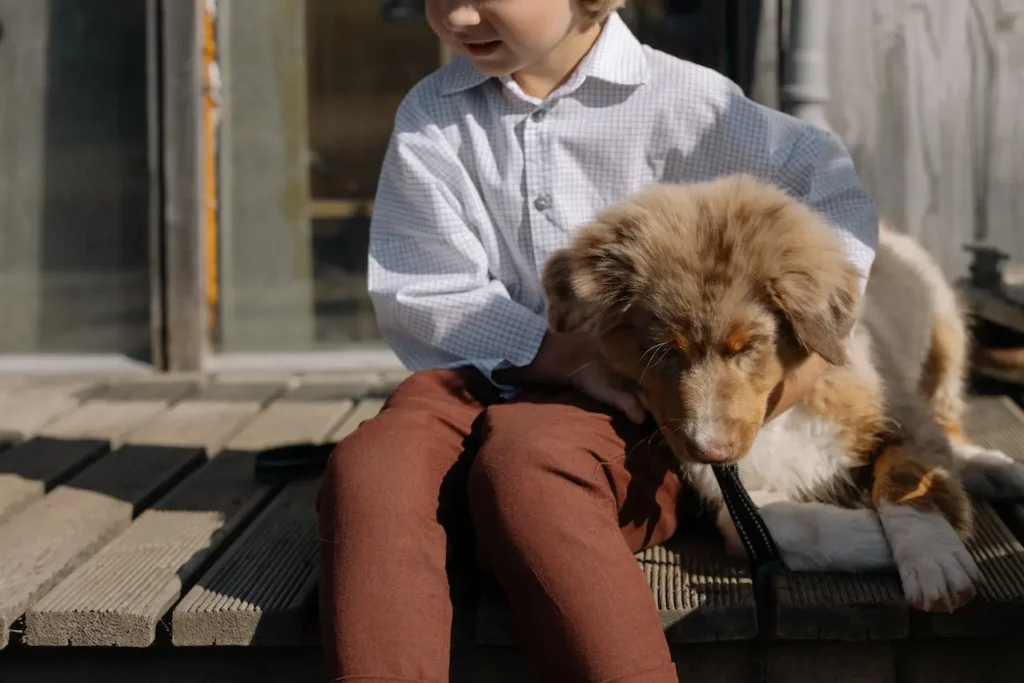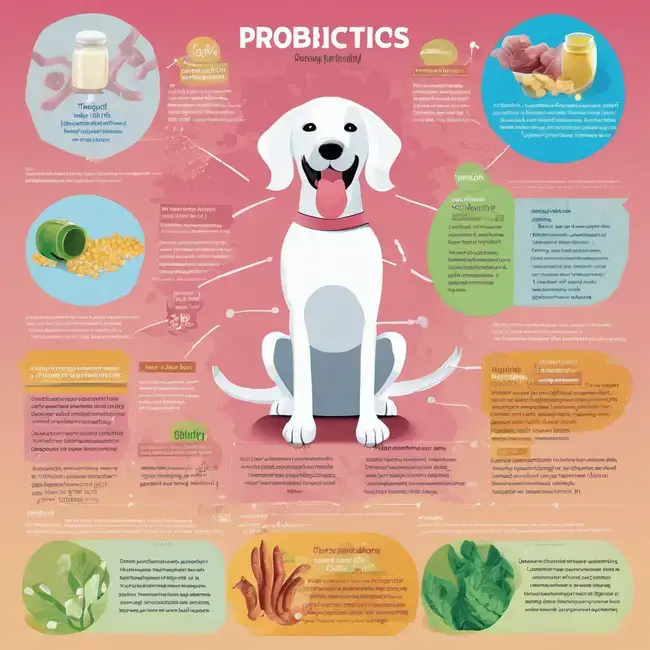How To Comfort a Dog with Pancreatitis | 11 Proven Tips

- What is Pancreatitis In Dogs?
- What Causes Pancreatitis In Dogs?
- 11 Proven Tips on How To Comfort a Dog With Pancreatitis
- Best Food for Dogs with Pancreatitis
- 11 Best Treats for Dogs with Pancreatitis
- Portion Sizes and Feeding Frequency
- What Foods Can Cause Pancreatitis In Dogs?
- Treatment for Dogs With Pancreatitis
- Symptoms of Dogs With Pancreatitis
- Diagnosis for Dogs With Pancreatitis
- Resources
- Conclusion
- Frequently Asked Questions (FAQs)
What is Pancreatitis In Dogs?
This post may contain affiliate links, meaning I may earn a commission if you make a purchase, at no extra cost to you. I only recommend products I trust. Thank you for your support.
Pancreatitis in dogs is a condition characterized by inflammation of the pancreas, an organ responsible for producing digestive enzymes and insulin.
Navigating the challenges of how to comfort a dog with pancreatitis requires a thoughtful approach.
Before delving into tips on how to comfort a dog with pancreatitis, it is essential to understand the underlying causes of pancreatitis in dogs.
Comforting a dog with pancreatitis includes providing a calm environment, offering gentle affection, and regular hydration to your dog.
The best food for dogs with pancreatitis includes low-fat meals such as chicken and rice, easily digestible proteins, and complex carbohydrates.
Treats for dogs with pancreatitis such as boneless and skinless chicken or turkey breasts, low-fat cottage cheese treats, and carrot stick treats.
Signs of pancreatitis in dogs include nausea, vomiting, fever, loss of appetite, and abdominal pain. Diagnosis involves blood tests, the SPEC-CPL test, and sometimes ultrasound imaging.
Pancreatitis in dogs can be caused by factors like high-fat diets, obesity, genetics, trauma, and certain medications.
Treatment includes allowing the dog to have enough rest, dietary management, fluid therapy, and pain management.

What Causes Pancreatitis In Dogs?
1. Dietary Factors
Pancreatitis in dogs can be triggered by the consumption of high-fat foods, table scraps, or fatty meats.
Dogs that consume these types of foods are at a higher risk of developing pancreatitis, as the pancreas becomes strained from processing excessive amounts of fat.
2. Obesity
Overweight dogs are more prone to developing pancreatitis.
The exact link between obesity and pancreatitis is not fully understood, but it is believed that excess fat tissue can contribute to inflammation of the pancreas.
3. Certain Medications
Some medications, particularly corticosteroids and certain antibiotics, have been associated with an increased risk of pancreatitis in dogs.
It’s important for pet owners to be aware of potential side effects and to monitor their dog’s health when initiating new medications.
4. Underlying Conditions
Dogs with underlying health issues such as diabetes or hyperlipidemia (elevated levels of fat in the blood) are at a higher risk of developing pancreatitis.
5. Genetics
Certain breeds, including miniature schnauzers, cocker spaniels, and yorkshire terriers, have a genetic predisposition to pancreatitis.
6. Age and Gender
Middle-aged to older dogs and female dogs are generally more susceptible to pancreatitis.
Age and gender can influence the likelihood of developing the condition.
7. Severe Trauma or Surgery
Severe trauma or recent abdominal surgery can elevate the risk of pancreatitis.
Inflammation may occur as a result of physical injury.
11 Proven Tips on How To Comfort a Dog With Pancreatitis
Now that we have insight into the causes of pancreatitis in dogs, it becomes imperative to approach the care of our dogs with a deeper understanding.
Comforting a dog with pancreatitis can be a challenging but important task.
But by following these tips, you can provide the necessary care and support for your dog with pancreatitis.
Here are 11 tips on how to comfort a dog with pancreatitis:
1. Regular Veterinary Check-ups
Find the best vet in your area and attend scheduled appointments to monitor your dog’s progress, receive a proper diagnosis, and get personalized guidance on managing pancreatitis.
2. Provide a Quiet Environment
Create a calm and quiet space for your dog to rest, away from loud noises like high-traffic areas and excessive activity, to minimize stress and discomfort.
3. Maintain a Consistent Feeding Schedule
Divide your dog’s daily food portion into several small meals and feed them at the same times each day to aid digestion and minimize strain on the pancreas.
4. Encourage Hydration
Ensure your dog has access to clean, fresh water at all times, and consider using a pet water fountain to encourage drinking.
Hydration is crucial for dogs with pancreatitis, so encourage drinking to prevent dehydration.
5. Monitor Pain Levels
Observe your dog for signs of discomfort such as reluctance to move, changes in posture, panting, or whining, and communicate any observations to your veterinarian.
6. Provide Comforting Activities
Engage your dog in short, leisurely walks in familiar and quiet surroundings to provide mental stimulation while being mindful of your dog’s energy levels.
7. Use Comforting Aids
Provide your dog with a plush and supportive orthopedic bed or blanket to help keep them warm and support their joints, relieving pressure on sensitive areas.
8. Administer Medication as Directed
Adhere to the prescribed medication schedule provided by your veterinarian, ensuring your dog receives the necessary relief for their condition.
9. Minimize Stress
Avoid sudden changes in routine or exposure to loud environments to minimize stress and anxiety for your dog during their recovery.
10. Show Affection and Reassurance
Spend quality time with your dog, offering gentle petting, soothing words, and a reassuring presence to provide emotional support throughout their recovery process.
11. Distraction with Toys
Introduce engaging toys to provide mental stimulation and divert your dog’s attention from any discomfort.
By incorporating these elaborations into your care routine, you can help provide your dog with the necessary support and comfort as they manage pancreatitis.
Best Food for Dogs with Pancreatitis
When considering suitable food for dogs with pancreatitis, it’s crucial to focus on providing easily digestible, low-fat, and balanced nutrition.
Here’s a detailed elaboration on what to feed a dog with pancreatitis:
1. Low-Fat Diets
Dietary choices for dogs with pancreatitis should prioritize foods that are low in fat, typically containing less than 10% fat content.
This is essential to reduce the workload on the pancreas and minimize the risk of triggering pancreatitis symptoms.
Look for commercial pet foods specifically labeled as “low-fat” or “digestive care.”
2. Easily Digestible Proteins
Select easily digestible protein sources such as lean meats, for example, boiled chicken or turkey.
These protein sources are gentle on the digestive system and provide essential nutrients without overburdening the pancreas.
Additionally, specific veterinary prescription diets designed for gastrointestinal health can offer tailored protein options.
3. Complex Carbohydrates
Incorporate easily digestible carbohydrates such as cooked rice, oatmeal, or sweet potatoes to provide a source of energy without overwhelming the digestive system.
These complex carbohydrates are gentle on the stomach and can contribute to a balanced diet for a dog with pancreatitis.
11 Best Treats for Dogs with Pancreatitis
When selecting treats for dogs with pancreatitis, it’s crucial to choose options that are low in fat, easily digestible, and gentle on the digestive system.
Here are 11 suitable treats for dogs with pancreatitis, along with explanations of their benefits:
1. Boiled Chicken or Turkey Treats
Lean meats like boiled chicken or turkey provide a high-quality protein source that is low in fat and easily digestible, making them suitable treats for dogs with pancreatitis.
Ingredients
- Boneless, skinless chicken or turkey breasts
Instructions
- Place boneless, skinless chicken or turkey breasts in a pot.
- Cover the meat with water, ensuring it is fully submerged.
- Bring the water to a boil over medium-high heat.
- Once boiling, reduce the heat to a simmer and cover the pot.
- Allow the meat to cook thoroughly until it reaches a safe internal temperature (165°F or 74°C).
- Remove the cooked meat from the pot and let it cool completely.
- Once cooled, cut the chicken or turkey into small, bite-sized pieces suitable for your dog’s size.
Tips
- Choose lean cuts of meat to minimize fat content.
- Avoid using any seasonings, spices, or oils during the cooking process, as these may be harsh on the digestive system.
2. Low-Fat Cottage Cheese Treats
Low-fat cottage cheese can be offered in small portions as a treat, providing a protein boost while being gentle on the digestive system due to its low-fat content.
Ingredients
- Unflavored, low-fat cottage cheese
Instructions
- Measure an appropriate portion of unflavored, low-fat cottage cheese based on your dog’s size and dietary requirements.
- Offer the measured portion directly to your dog as a treat.
- Ensure that the portion size aligns with your dog’s overall diet and doesn’t exceed recommended amounts.
Tips
- Avoid adding any ingredients that might be less suitable for dogs, such as sugars or flavorings.
- Keep portions small and suitable for your dog’s size to prevent overfeeding.
3. Cooked Sweet Potato Treats
Cooked sweet potatoes are a nutritious, low-fat treat option that offers vitamins, fiber, and complex carbohydrates, promoting digestive health and providing a tasty reward.
Ingredients
- Sweet potatoes
Instructions
- Place sweet potatoes in a pot with water and boil until tender.
- Allow the cooked sweet potatoes to cool completely before handling.
- Cut the cooled sweet potatoes into small, dog-friendly portions.
- Ensure the pieces are bite-sized and suitable for your dog’s size.
- Serve the sweet potato treats to your dog in their natural state, without adding any seasonings or toppings.
Tips
- Choose fresh, quality sweet potatoes without any signs of spoilage.
- Adjust the portion size based on your dog’s size and dietary needs.
4. Carrot Sticks Treats
Carrot sticks are low in calories and high in fiber, making them a satisfying and crunchy treat that is gentle on the digestive system and suitable for dogs with pancreatitis.
Ingredients
- Fresh carrots
Instructions
- Wash and peel the carrots to remove any dirt or residue.
- Cut the carrots into stick-shaped pieces, ensuring they are an appropriate size for your dog to chew on.
- Make sure the pieces are bite-sized and manageable for your dog’s size.
- Offer the raw carrot sticks to your dog as a crunchy and low-calorie treat.
Tips
- Choose fresh, firm carrots without signs of spoilage.
- Adjust the size of the carrot sticks based on your dog’s size and chewing ability.
5. Green Bean Treats
Cooked or raw green beans can serve as a low-calorie, fiber-rich treat option, supporting digestive health and providing a satisfying crunch for the dog.
Ingredients
- Fresh green beans
Instructions
- Steam or blanch fresh green beans until they are tender but still slightly crisp to retain nutrients and provide a satisfying crunch for your dog.
- Allow the cooked green beans to cool completely before serving.
- Serve the green beans as whole or cut into smaller pieces, depending on the size of your dog.
Tips
- Choose fresh, crisp green beans without any signs of spoilage.
- Adjust the size of the green bean pieces based on your dog’s size and chewing preferences.
6. Apple Slices (without seeds)
Apple slices, when offered in moderation and without seeds, can provide a sweet and crunchy treat that is low in fat and contains beneficial nutrients for the dog.
Ingredients
- Fresh apple
Instructions
- Wash the apple thoroughly to remove any residue.
- Ensure that all seeds and the core are completely removed from the apple slices.
- Apple seeds contain cyanide, which is harmful to dogs.
- Slice the cored apple into pieces appropriate for your dog to enjoy.
- Provide the apple pieces in moderation due to the natural sugars present in apples.
Tips
- Choose fresh and crisp apples, and consider using organic apples to minimize exposure to pesticides.
- Adjust the size of the apple slices based on your dog’s size and chewing ability.
7. Cooked White Rice Treats
Cooked white rice can be offered as a bland, easily digestible treat for dogs with pancreatitis, providing a source of energy without adding stress to the digestive system.
Ingredients
- White rice
Instructions
- Wash the white rice thoroughly to remove excess starch.
- Rinsing helps lower the starch content, making it gentler for the dog’s digestive system.
- Rinsing rice can also remove grit, dust, and debris thus avoiding irritation to the dog’s digestive tract.
- Prepare plain white rice by boiling it in water until fully cooked.
- Allow the cooked white rice to cool completely before serving.
- Serve small amounts of the cooled white rice as treats for your dog.
Tips
- Adjust the portion size based on your dog’s size and dietary needs.
8. Lean Fish Treats
Lean fish such as boiled white fish can be served as a low-fat, protein-rich treat option that supports the dog’s nutritional needs without overwhelming the pancreas.
Ingredients
- White fish (e.g., cod or haddock)
Instructions
- Choose lean fish varieties like cod or haddock for a low-fat, protein-rich treat.
- Boil white fish in water until fully cooked.
- Once the fish is cooked and cooled, flake it into small, bite-sized portions suitable for your dog’s size.
- Offer the flaked fish to your dog in its natural form as a nutritious, low-fat treat.
Tips
- Use white fish without added seasonings or oils to maintain the treat’s nutritional benefits.
- Adjust portion sizes based on your dog’s size and dietary requirements.
9. Low-fat, Plain Yogurt Treats
Plain yogurt with no added sugars or artificial sweeteners can offer probiotic benefits for dogs and a creamy treat option that is low in fat and gentle on the stomach.
Ingredients
- Plain, unflavored yogurt with live cultures
Instructions
- Offer small amounts of plain, unflavored yogurt to your dog as a creamy and low-fat treat.
- Ensure that the yogurt contains no added sugars or artificial sweeteners.
- Measure an appropriate portion based on your dog’s size and dietary needs.
- Serve the measured portion of yogurt directly to your dog.
Tips:
- Choose plain yogurt with live cultures to provide probiotic benefits for digestive health.
- Adjust portion sizes according to your dog’s size and nutritional requirements.
10. Pumpkin Puree Treats
Plain, unsweetened pumpkin puree can serve as a low-fat, fiber-rich treat that supports digestive health and provides a flavorful reward for the dog.
Ingredients
- Plain, unsweetened pumpkin puree (100% pure).
Instructions
- Look for 100% pure pumpkin puree with no added ingredients.
- This ensures it is gentle on the digestive system and provides optimal nutritional benefits.
- Offer small amounts of plain, unsweetened pumpkin puree to your dog as a flavorful and low-fat treat.
- Use moderation when serving.
Tips:
- Pumpkin puree is rich in fiber, which can aid in digestive health.
- Adjust the serving size based on your dog’s size and dietary requirements.
11. Homemade Cantaloupe Dog Treats

There are numerous benefits of cantaloupe for dogs. The low fat and fiber content in cantaloupe can aid in digestion and help regulate bowel movements.
Ingredients
- Fresh cantaloupe
Instructions
- Wash the cantaloupe thoroughly to remove any dirt or residue from the skin.
- Remove the seeds and peel to ensure safe consumption.
- Remove or peel off the tough outer rind of the cantaloupe.
- Cut the cantaloupe into small, bite-sized pieces suitable for your dog’s size.
- Offer the fresh cantaloupe pieces to your dog in moderation.
Tips
- Adjust the portion size based on your dog’s size and dietary needs.
- Avoid excessive consumption of cantaloupe, or any treat since it can lead to digestive issues, including diarrhea or stomach upset.
Portion Sizes and Feeding Frequency
1. Small, Frequent Meals
Dividing the dog’s daily food portion into several small meals throughout the day is crucial for aiding digestion and minimizing the strain on the pancreas.
This approach prevents the pancreas from being overloaded with a large amount of food at once, reducing the risk of exacerbating pancreatitis symptoms.
2. Portion Control
Portion control helps maintain a consistent feeding routine and supports the dog’s digestive health by preventing excessive food consumption at any given time.
Measuring and controlling portion sizes is vital to prevent overeating and manage the dog’s overall calorie intake.
What Foods Can Cause Pancreatitis In Dogs?
These foods can trigger pancreatitis in dogs and its better to avoid them.
1. High-Fat Foods
Avoid feeding high-fat foods such as fatty cuts of meat, fried foods, and fatty treats.
These foods can trigger pancreatitis symptoms and strain the pancreas, leading to discomfort and potential complications.
Opt for lean protein sources and low-fat alternatives to support the dog’s digestive well-being.
2. Spices and Seasonings
Refrain from adding spices, seasonings, or excessive salt to the dog’s meals, as these can irritate the digestive system and potentially contribute to gastrointestinal distress.
Keeping the diet simple and free from added spices supports the dog’s digestive comfort.
3. Certain Fruits and Vegetables
Some fruits and vegetables, such as avocados, grapes, and onions, are toxic to dogs and should be strictly avoided.
These items can be harmful and may exacerbate digestive issues, making it essential to be cautious when selecting fruits and vegetables for the dog’s diet.
Treatment for Dogs With Pancreatitis
Treatment of pancreatitis in dogs will be evaluated and determined by a veterinarian.
Some common methods of treatment of pancreatitis in dogs include:
1. Dietary Management
Dogs with pancreatitis are typically placed on low-fat, easily digestible diets to reduce stress on the pancreas.
This may involve feeding prescription diets specifically formulated for gastrointestinal health.
2. Fluid Therapy
Dogs with pancreatitis may be at risk of fluid imbalances due to vomiting and decreased fluid intake.
Intravenous fluids are administered to address dehydration and support organ function.
3. Medication
Pain management, anti-nausea medication, and antibiotics may be prescribed as part of the treatment plan to alleviate discomfort, manage symptoms, and address potential secondary infections.
4. Proper Rest
Minimizing activity and providing a calm, stress-free environment is important for aiding in the dog’s recovery and reducing strain on the pancreas.
Symptoms of Dogs With Pancreatitis
Recognizing the signs and symptoms of pancreatitis in dogs is crucial for early detection and treatment.
Common symptoms include:
1. Gastrointestinal Distress
Dogs with pancreatitis may exhibit symptoms such as vomiting, diarrhea, and a reduced appetite.
These digestive disturbances are indicative of the inflammation affecting the pancreas’s ability to produce digestive enzymes.

2. Abdominal Pain
Dogs with pancreatitis may show signs of discomfort, restlessness, or reluctance to move.
They may exhibit a hunched posture, indicating abdominal discomfort.
3. Dehydration
Pancreatitis can lead to increased thirst and decreased urination, potentially resulting in dehydration.
Monitoring the dog’s water intake and urine output is important.
4. Lethargy
Dogs with pancreatitis may display lethargy, lack of energy, and reduced activity levels.
This is often a result of the overall systemic inflammation and discomfort associated with the condition.
5. Fever
In response to inflammation, dogs with pancreatitis may develop an elevated body temperature, indicating the body’s natural response to the inflammatory process.
Diagnosis for Dogs With Pancreatitis
Diagnosing pancreatitis in dogs requires a comprehensive evaluation by a veterinarian.
Some common methods of diagnosing pancreatitis in dogs include:
1. Physical Examination
Veterinarians assess a dog’s symptoms, including abdominal discomfort, and conduct a thorough physical examination to evaluate their overall condition.
2. Blood Tests
Blood tests can help assess the levels of pancreatic enzymes, such as lipase and amylase, which are often elevated in cases of pancreatitis.
Additional blood parameters are also evaluated to gauge the dog’s overall health status.
3. Imaging
X-rays or ultrasound may be used to visualize the pancreas and surrounding abdominal structures, aiding in the diagnosis of pancreatitis and ruling out other potential causes of the dog’s symptoms.
Resources
For further details on how to comfort a dog with pancreatitis or pancreatitis in dogs, you can explore the following resources:
- Pursing Pancreatitis: A Clinical Researcher’s Work on a Prevalent Disorder in Dogs by Harry Cridge.
- New advances in the diagnosis of canine and feline liver and pancreatic disease by Jonathan A Lidbury and Jan S Suchodolski.
- Pancreatitis in dogs and cats: definitions and pathophysiology by P Watson.
- Chronic pancreatitis in dogs: a retrospective study of clinical, clinicopathological, and histopathological findings in 61 cases by Brier M Bostrom, Panagiotis G Xenoulis, and Shelley J Newman.
Conclusion
In conclusion, how to comfort a dog with pancreatitis involves a multi-faceted approach aimed at alleviating their discomfort and aiding in the recovery process.
By understanding the signs and symptoms of pancreatitis in dogs, creating a soothing environment, and providing suitable food for dogs with pancreatitis, you can help ease your dog’s discomfort and support their recovery.
Always work closely with your veterinarian to develop a comprehensive treatment plan tailored to your dog’s specific needs.
With proper care and attention, you can make a significant difference in your dog’s quality of life and overall well-being.
South Beach Diet For Weight Loss.
Frequently Asked Questions (FAQs)
How to comfort a dog with pancreatitis?
To comfort a dog with pancreatitis, provide a calm setting with soft bedding, gentle affection, and regular hydration.
Adhere strictly to a low-fat diet, administer medications consistently, and monitor for any behavioral changes.
Regular veterinary check-ups offer ongoing guidance for effective symptom management.
What causes pancreatitis in dogs?
Pancreatitis in dogs can be caused by various factors, including:
- High-fat diet
- Obesity
- Genetics
- Trauma
- Medications like corticosteroids
How is pancreatitis in dogs diagnosed?
Diagnosis of pancreatitis in dogs is typically done through:
- Blood tests to look for an elevation in white blood cells and pancreatic enzymes.
- The SPEC-CPL test, providing a rapid diagnosis by detecting elevated lipase levels.
- In some cases, an ultrasound may be performed to visualize inflammation.
How to prevent pancreatitis in dogs?
To prevent pancreatitis in dogs, you can:
- Feed a healthy, low-fat diet
- Maintain a healthy weight
- Avoid table scraps and high-fat foods
- Ensure regular veterinary check-ups
What is the treatment for pancreatitis in dogs?
The treatment for pancreatitis in dogs involves:
- Providing low-fat, highly digestible food.
- Fluid therapy to maintain hydration.
- Pain medication and anti-inflammatory drugs if necessary.
If you suspect that your dog may have pancreatitis, it is crucial to consult with your veterinarian for an accurate diagnosis and appropriate treatment.
Remember, this article is not a substitute for professional veterinary advice.



